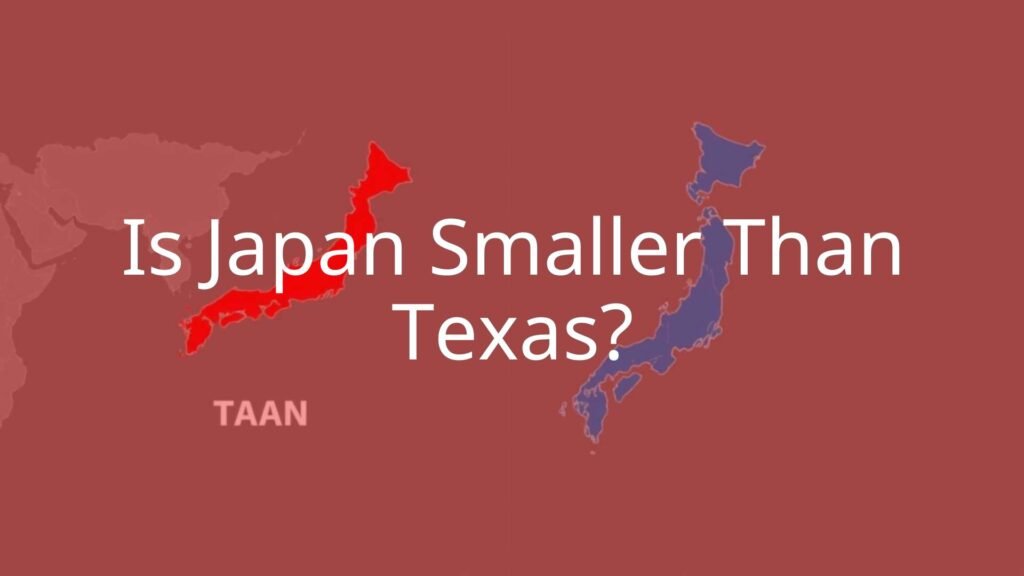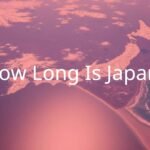Quick Facts and Simple Explanation
Yes, Japan is smaller than Texas. While both are important in different ways, Texas is much bigger than Japan in terms of land size. Texas is the second-largest state in the United States, which surprises some people since Japan is a famous country with a large population and global impact. However, looking just at the land size, Texas is clearly bigger.
To make it easy, Texas is about 1.8 times the size of Japan. If you placed a map of Japan over Texas, a lot of Texas would still be left uncovered. In other words, Texas is around 79% larger than Japan. This shows just how large Texas really is, with many types of land and weather within its borders.

What Does ‘Smaller’ Mean: Size, People, or Something Else?
When we compare the size of two places, it helps to know what we mean by “smaller.” Are we talking about land size, population, or money and economy? Here, we’re talking mostly about land size, so by area, yes, Japan is smaller than Texas.
But if we look at the number of people, things change a lot. Japan has many more people than Texas, even though it’s smaller. This means Japan’s cities are much fuller than Texas’s. If we look at money and economy (measured with GDP), Japan is also ahead of Texas, since it’s one of the world’s wealthiest countries. So, Texas has a bigger land area, but Japan has more people and a larger economy.
Size Comparison: Japan vs Texas
Japan’s Area (Square Miles and Kilometers)
Japan is made up of four main islands-Honshu, Hokkaido, Kyushu, and Shikoku-plus thousands of smaller ones. The total land area of Japan is about 377,975 square kilometers, or about 145,937 square miles. Much of Japan is covered by mountains, so people mostly live along the coasts or in cities. Because of this, most of the flat, usable land is crowded.
Japan lies between the Sea of Okhotsk in the north and the East China Sea and Taiwan in the south. This location gives Japan striking scenery, but also causes earthquakes and volcanoes. Japan’s long shape and many islands mean it has a long coastline compared to its land area.

Texas Area (Square Miles and Kilometers)
Texas is the second biggest state in the U.S. Its total size is about 678,052 square kilometers, or around 268,597 square miles. Texas borders Mexico to the south and the U.S. states of New Mexico, Oklahoma, Arkansas, and Louisiana. The state contains deserts, forests, plains, and a long Gulf coast.
Texas is famous for being large-you can drive for over 11 hours and still be in Texas. For example, it takes about 11 hours to get from McAllen to Amarillo or about 12 hours from Beaumont to El Paso. This gives Texas plenty of room for both big cities and wide open spaces.
How Does Japan’s Size Compare to Texas?
Based on area alone, Japan is much smaller than Texas.
| Area (sq km) | Area (sq mi) | |
|---|---|---|
| Japan | 377,975 | 145,937 |
| Texas | 678,052 | 268,597 |
If you compare the two: Japan is about 54% the size of Texas. In other words, you could almost fit two Japans inside Texas, and still have some extra room. This basic comparison shows how big Texas is next to Japan, even though Japan is a well-known, major country.

Visualizing the Difference on a Map
Seeing the two side by side on a map helps make the difference more clear. If you draw Japan over Texas, Texas easily surrounds Japan, with lots left over. Sometimes, maps make places near the poles look bigger, but even taking this into account, Texas is much larger than Japan.
To give some more context, Texas is bigger than countries like France, Germany, and the United Kingdom. France and Germany are each about 70% the size of Texas. The UK is less than one-fifth as big as Texas. Alaska, which is the biggest U.S. state, is much bigger than Japan-it’s over four times Japan’s size. So, Texas is large even compared to whole countries.
Population: Japan vs Texas
How Many People Live in Japan?
Japan, while smaller in area, has a lot of people-about 124.2 million to 125 million. That’s one of the largest populations in the world. Since so much of Japan is covered with mountains, most people live near the coast or in big cities, making those areas very crowded.
This crowding affects daily life. Cities like Tokyo, Osaka, and Nagoya are packed and busy, filled with business, technology, and exciting culture. People in Japan are used to living in apartments or small houses and using fast and efficient public transportation.
How Many People Live in Texas?
In 2023, Texas had about 30.5 million residents (some sources say about 29 million, depending on the year). Texas is the second-most populated state in the U.S., but still has far fewer people than Japan-Japan has over four times more people than Texas.
Because Texas is so big, its people are more spread out. Texas has its own large cities, like Houston, Dallas, San Antonio, and Austin, and most people live in or near these. The “Texas Triangle”-which links Dallas, Fort Worth, Houston, Austin, and San Antonio-holds more than 21 million of the state’s people, but there are still plenty of small towns and countryside in between.
Comparing Population Density
The real difference comes when we look at how close together people live. Here’s a look at the numbers:
| Population (approx.) | Land Area (sq km) | People per sq km | |
|---|---|---|---|
| Japan | 125,000,000 | 377,975 | ~331 |
| Texas | 30,500,000 | 678,052 | ~45 |
Japan’s population density is much higher than Texas’s. That means people in Japan live much closer together, while in Texas, there is more space per person. This changes how people live, travel, and build their communities.

Common Questions about Japan and Texas Size
How Many Japans Would Fit in Texas?
About 1.8 Japans fit in Texas. More simply, since Japan is 54% of Texas’s size, you could fit nearly two Japans inside Texas’s borders, with room to spare. This fact helps show just how vast Texas is, especially when comparing it to a large, well-known country like Japan.
Comparisons like this help people realize that Texas is unusually big even on a world scale. While Japan is influential and crowded, its land area covers much less ground than Texas does.
Does Land Size Change Economy, Culture, or Travel?
Yes, the size and shape of a place make a big difference. In Japan, the small, crowded land means that cities are very organized, public transit is fast and reliable, and people use space wisely. The country’s businesses focus on technology and careful manufacturing, thank to a skilled and dense workforce. Trains make it easy to move between cities, even if the land is rough or hilly.
Texas uses its big open spaces for many different things. Farms, oil fields, factories, and cities all have room to grow. Texas’s size has helped it build a strong economy based on energy, farming, technology, and space exploration. The state has many different regions, each with a unique feel, from the dry western areas to the forests and swamps of the east. Because there is so much space, driving is common, and it can take many hours to get from one part of Texas to another. You can also find all kinds of weather, plants, and animals throughout the state.
All in all, Japan’s crowded geography leads to tight, efficient cities and fast trains, while Texas’s open space means spread-out cities, farms, and a car-focused lifestyle. Each place has its own strengths and challenges, shaped by its land.
- What Is a Maiko? - July 13, 2025
- What Does Domo Arigato Mean? - July 12, 2025
- What Does Naruto Mean? - July 12, 2025









